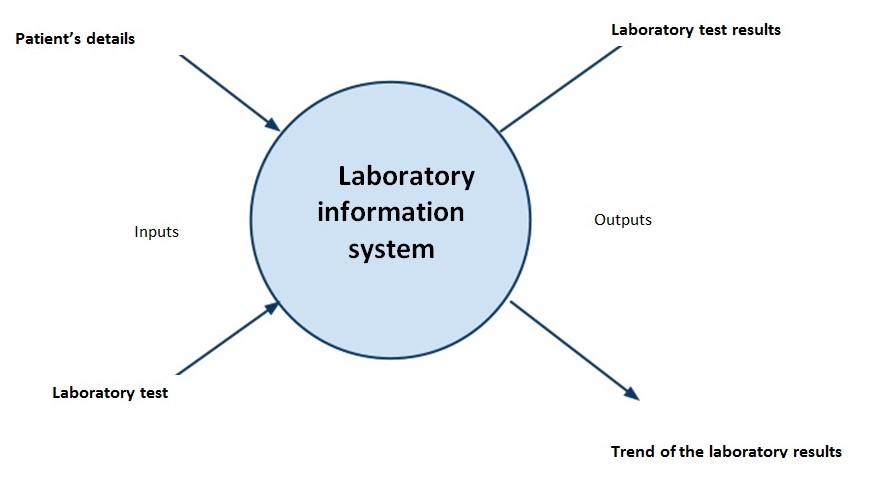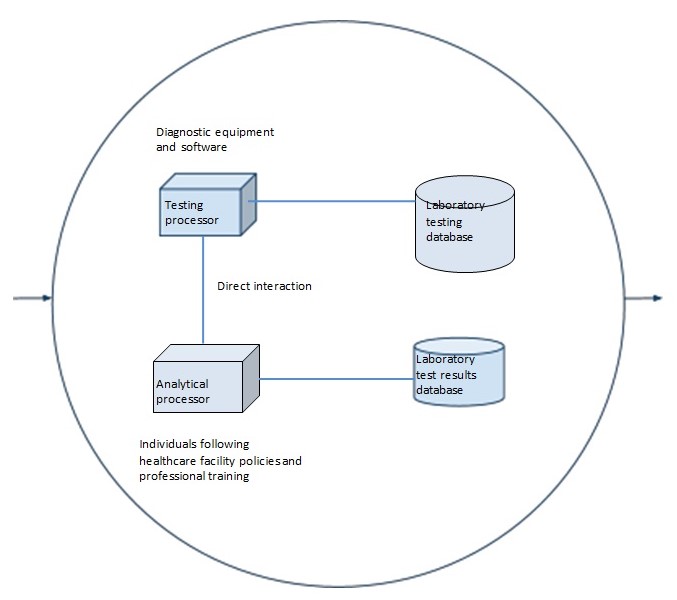General Description of the Information System
This section provides a general description and of the information system. It documents the title, overall function, and the users of an information system and what they wish to do with the information system (or the information system does for them).
General Description
Laboratory information system is a software application that receives, processes, and stores information that various medical laboratories generate (Wolper, 2004, p. 689). Laboratory information system helps in generating results that aid medical practitioners in decision-making (Price, St. John & Hicks, 2004, p. 276). For a laboratory information system to work effectively, it must integrate with the hospital information system of the medical facility. In addition, the laboratory information system must have direct interaction with laboratory testing equipment for ease of production of relevant information (Magjarevic, Suh & Nagel, 2007, p. 449). Availability of a centralised patient record would increase the efficiency of the laboratory information, as the laboratory information system would tap into the centralised system to obtain relevant data (Saetnan, Lomell, Hammer, 2011, p. 179).
Users (or Other Information Systems) and User Functions
- Laboratory specialist – the medical practitioner who is undertaking laboratory tests on the patient
- Patient
- Physician – the medical practitioner who supervises the patient and orders for the laboratory tests
- Hospital information system – the information system that stores all the medical records of all patients within the hospital
Instance
The laboratory information system may find great use in a healthcare facilities chain that offers laboratory services.
External description of the information system
This section provides details of the inputs and outputs of the information system, the information processing that the information system performs, the information that the information system stores, and the system boundary. This section does not focus on any information and communication technologies, but the information processing itself.
Inputs
Patient’s personal details:
- Name and contact details
- Gender
- Medical number
- ID number
- Brief medical history of the patient
- Requested laboratory tests
Outputs
- Results of various laboratory tests
- Measures of the indicators of quality control, which include precision, accuracy, sensitivity and specificity of the tests to determine the reliability of the tests
- The trend of the results of a particular test
The outcome of the tests – whether positive or negative – may prompt the medical practitioner to recommend for further tests to determine the severity of an ailment or get results that are more accurate.
Information processing
The laboratory information system processes the necessary information to determine the medical condition of the patient.
Information Stored
The laboratory information system stores the patient’s personal details (name, age, sex, ID number and contact details), results of the tests, and recommendation for further tests.
System Boundary
The laboratory information system stores and processes all medical tests related information of the patient. However, the information system sources information on the medical history of the patient externally from the hospital information system of the medical facility. Therefore, determining the system boundary would help in improving the information system’s security (Barber, Treacher & Louwerse, 1996, p. 197)
External (outside) Components
- The patient
- Hospital information system
Internal (inside) Components
- Laboratory testing equipment
- Laboratory analytical processor
External View of the Information System

Internal Description of the Information System
This section provides an internal description of the information system including the particular information processors, information stores, and any networks within the information system. It focuses on the information and communication technologies used to implement (or realise) the information processing, storage and communication needed for the information system.
Information Processors
- Laboratory testing processor – these are laboratory testing equipment that undertake various laboratory tests.
- Laboratory analytical processor – this individual receives and analyses information from the laboratory information system.
Information Stores
- Patients’ records database – contains the patient’s number and laboratory results for various tests. However, the hospital information system of the healthcare facility stores more detailed information on the patient.
- Patient’s laboratory results filing cabinet – contains the laboratory results of all patients.
System Boundary
Storage and processing of all information takes place within the laboratory information system. The laboratory information system obtains only the patient’s medical history from the hospital information system.
Networks
Internal Networks
There is a direct contact connection between laboratory testing equipment and the laboratory information system (Kottke-Marchant & Davis, 2012, p. 652).
External Networks
There is direct connection between the laboratory information system and the hospital information system. This gives the laboratory information system access to more detailed medical history of the patient (Ball & Collen, 1992, p. 133).
The laboratory information system sends the laboratory tests results to the medical practitioner handling the patient via the healthcare facility’s intranet or via the internet.
Internal View of the Information System

Further Notes
The laboratory information system cannot work without human intervention. The information system only provides medical practitioner with information that would aid them in making decisions. However, the ultimate decision lies with the medical practitioner and the patient’s consent to the medical practitioner’s decision (Coleman & Tsongalis, 2006, p. 546). Centralisation of medical records would greatly help in improving the efficiency of the laboratory information system, as the system would tap into the centralised record to obtain readily available information (Swayne, Duncan, Ginter, 2006, p. 401). However, centralisation of medical records raises the issue of security and privacy of patient’s medical records (Conrick, 2006, p. 322).
References
Ball, MJ & Collen, MF. 1992. Aspects of the computer-based patient record. London: Springer.
Barber, B, Treacher A & Louwerse, K. 1996. Towards security in medical telematics: legal and technical aspects. Lansdale, PA: IOS Press.
Coleman, WB & Tsongalis, GJ. 2006. Molecular diagnostics: For the clinical laboratorian. London: Springer.
Conrick, M. 2006. Health informatics. Belmont, CA: Cengage Learning.
Kottke-Marchant, K & Davis, B. 2012. Laboratory hematology practice. Hoboken, NJ: John Wiley & Sons.
Magjarevic, R, Suh, TS & Nagel, JH. 2007. World congress on medical physics and biomedical engineering 2006: August 27 – September 1, 2006, COEX Seoul, Korea : “Imaging the future medicine”, Volume 1. London: Springer.
Price, CP, St. John, A & Hicks, JM. 2004. Point-of-care testing. Washington, DC: American Association for Clinical Chemistry.
Saetnan, AR, Lomell, HM & Hammer, S. 2011. The mutual construction of statistics and society. Oxon: Taylor & Francis.
Swayne, LE, Duncan, WJ & Ginter, PM. 2006. Strategic management of health care organizations. Hoboken, NJ: John Wiley & Sons.
Wolper, LF. 2004. Health care administration: planning, implementing, and managing organized delivery system. Sudbury, MA: Jones & Bartlett Learning.